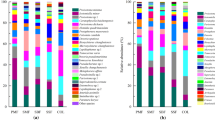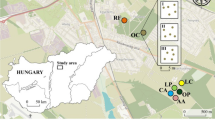Abstract
A soil arthropod community was studied in a dry evergreen forest over a 3-year period from May 1998 to April 2001. Population abundance, species composition, and community structure were investigated over the 3-year study period. The soil arthropods consisted of Acari (75.38%), Collembola (16.11%), and others (8.51%), and their abundances showed a clear difference between the rainy and dry seasons. Population abundance of Collembola and Acari were low during drought conditions. The humidity was the most important factor determining distribution, abundance, and survival of soil Collembola in this tropical forest. High predation and low accumulation of organic matter caused low population abundance of Collembola in the tropical habitat. The collembolan community was dominated by a few dominant species over the study period. The pattern of seasonal changes in numbers of Collembola was similar over the 3-year study period. The species composition of the collembolan community was constant and persistent throughout a 3-year study period. Thus, the collembolan community showed constancy in its species composition with seasonal variability over the 3-year study period.









Similar content being viewed by others
References
Badejo MA, Van Straalen NM (1993) Seasonal abundance of springtails in two contrasting environments. Biotropica 25:222–228
Beck L (1967) Die bodenfauna des neotropischen regenwaldes, Atlas do Simposio sobre a Biota Amazonica, 5 (Zoology), pp 97–101
Belfield W (1956) The Arthropoda of the soil in a West African pasture. J Anim Ecol 25:275–287
Block W (1970) Micro-arthropoda in some Uganda soils. In: Phillipson J (eds) Proceedings of a UNESCO/IBP symposium on methods of study in soil ecology. UNESCO, Paris, pp 195–202
Critchley BR, Cook AG, Critchley U, Perfect TJ, Russell-Smith A, Yeadon R (1979) Effects of bush clearing and soil cultivation on the invertebrate fauna of a forest soil in the humid tropical. Pedobiologia 19:425–438
Culik MP, Filho DZ (2003) Diversity and distribution of Collembola (Arthropoda: Hexapoda) of Brazil. Biodivers Conserv 12:1119–1143
Deharveng L, Bedos A (1993) Factors influencing diversity of soil Collembola in a tropical mountain forest (Doi Inthanon, Northern Thailand). In: Paoletti MG, Foissner W, Coleman D (eds) Soil biota, nutrient cycling, and farming systems. Lewis, London, pp 91–111
Di Castri F (1963) Etat de nos connaissances sur les biocenoses edaphiques du Chili. In: Doeksen J, van der Drift J (eds) Soil organisms. North Holland, Amsterdam, pp 375–385
Goehring DM, Daily GC, Sekercioglu CH (2002) Distribution of ground-dwelling arthropods in tropical countryside habitats. J Insect Conserv 6:83–91
Gonzalez G, Ley RE, Schmidt ST (2001) Soil ecological interactions: compositions between tropical and subalpine forests. Oecologia 128:549–556
Hasegawa M, Takeda H (1995) Changes in feeding attributes of 4 collembolan populations during the decomposition process of pine needles. Pedobiologia 39:155–169
Heneghan L, Coleman DC, Zou X, Crossley DA, Haines BL (1998) Soil microarthropod community structure and litter decomposition dynamics: a study of tropical and temperate sites. Appl Soil Ecol 9:33–38
Heneghan L, Coleman DC, Zou X, Crossley DA, Haines BL (1999) Soil microarthropod contributions to decomposition dynamics: tropical-temperate comparisons of a single substrate. Ecology 80:1873–1882
Kanzaki M, Yoda K, Dammanonda P (1995) Mosaic structure and tree growth pattern in a monodominant tropical seasonal evergreen forest in Thailand. In: Box EO, et al, (eds) Vegetation science in forestry. Kluwer Academic, Dordrecht, pp 495–513
Lasebikan BA (1975) The effect of clearing on the soil arthropods of a Nigerian rain forest. Biotropica 7:84–89
Lavelle P, Blanchart E, Martin A, Martin S, Barois I, Toutian F, Spain A, Schaefer R (1992) A hierarchical model for decomposition in terrestrial ecosystem: application to soils in the humid tropics. Biotropica 25: 130–150
Lavelle P, Bignel D, Lepagge M, Wolters V, Roger P, Head OW, Dhillion S (1997) Soil function in a changing world: the role of invertebrate ecosystem engineers. Euro J Soil Biol 33:159–193
Madge DS (1965) Leaf fall and litter disappearance in a tropical forest. Pedobiologia 5:237–288
Maldague ME, Hilger F (1963) Observations faunistiques et microbiologiques dans quelques biotropes foresties equatoriaux. In: Doeksen J, van der Drift J (eds) Soil organisms. North Holland, Amsterdam, pp 368–375
Morishita M (1959) Measuring of interspecific association and similality btweeen communties. Mem Fac Sci Kyushu Univ Ser E (Biol) 3:65–80
Ogino K, Saichual P, Imadate G (1965) Seasonal changes of soil microarthropod in central Thailand. Nat Life Southeast Asia 14:303–315
Petersen H, Luxton M (1982) A comparative analysis of soil fauna populations and their role in decomposition process. Oikos 39:288–388
Pfeiffer WJ (1996) Litter invertebrates. In: Regan DP, Waide RB (eds) The food web of a tropical rain forest. Chicago University Press, Chicago, pp 137–183
Sakurai K, Tanaka S, Ishizuki S, Kanzaki M (1998) Difference in soil properties of dry evergreen and dry deciduous forest in the Sakaerat Environmental Research Station. Tropics 108:61–80
Seastedt TR (1984) The role of microarthropods in decomposition and mineralization processes. Annu Rev Entomol 29:25–46
Siegel S (1956) Nonparametric statistics for the behavioural sciences. McGraw Hill Kogakusha, Tokyo
Stanton N (1979) Patterns of species diversity in temperate and tropical litter mites. Ecology 60:295–304
Swift MJ, Heal OW, Anderson JM (1979) Decomposition in terrestrial ecosystem. Blackwells, Oxford
Takeda H (1981) Effects of shifting cultivation on the soil meso-fauna with species reference to collembolan populations in the north-east Thailand. Mem Coll Agric Kyoto Univ 118:45–60
Takeda H (1984) A long term study of life cycle and population dynamics of Folsomia octoculata Handschin (Insecta:Collembola) in a pine forest soil. Res Popul Ecol 26:188–219
Takeda H (1987) Dynamics and maintenance of collembolan community structure in a forest soil system. Res Popul Ecol 29:291–346
Takeda H (1995) Templates for the organization of collembolan communities. In: Edwards CA, Abe T, Striganova BR (eds) Structure and function of soil communties. Kyoto University Press, Kyoto, pp 1–18
Takeda H (1996) Templates for the organization of soil animal communities in tropical forests. In: Turner IM, Diong CH, Lim SS, Ng PK (eds) Biodiversity and the dynamics of ecosystems (eds) DIWPA Ser 1:217–226
Takeda H, Abe T (2001) Templates of food-habitat resources for the organization of soil animals in temperate ad tropical forests. Ecol Res 16:961–973
Takeda H, Ichimura T (1983) Feeding attributes of 4 collembolan species in a pine forest soil. Pedobiologia 25:373-381
Wachrinrat C (2000) Community dynamics of building phase in fire and non-fire protected secondary dry dipterocarp forest, Nakhon Ratchasima. Department of Silviculture, Faculty of Forestry, Kasetsart University, Bangkok
Wallwork JA (1976) The distribution and diversity of soil fauna. Academic, London
Wolda H (1983) Spatial and temporal variation in abundance in tropical animals. In: Sutton SL, Whitmore TC, Chadwick AC (eds) Tropical rain forest: ecology and management. Blackwell Scientific, Oxford, pp 93–105
Yamashita T, Takeda H (1998) Decomposition and nutrient dynamics of leaf litter in litter bags of two mesh sizes set in two dipterocarp forest sites in Peninsular Malaysia. Pedobiologia 42:11–21
Zou X, Zucca CP, Waide RB, McDowell WH (1995) Long-term influence of deforestation on tree species composition and litter dynamics of a tropical rain forest in Puerto Rico. For Ecol Manage 78:147–157
Acknowledgements
We would like to thank the students of the Forest Entomology Laboratory, Faculty of Forestry, Kasetsart University for their assistance in the sampling of soil arthropods and to Drs. M. Hasegawa and Barclay Hugh (Pacific Forestry Center, Canada) for their helpful comments on the manuscript.
Author information
Authors and Affiliations
Corresponding author
Appendix
Appendix
The abundance of collembolan species; density is expressed as numbers per m2. The mean densities are calculated over the 3 years
Species | First year Mean±S.E. | Second year Mean±S.E. | Third year Mean±S.E. | Mean | Relative abundance (%) |
|---|---|---|---|---|---|
1. Isotomiella minor | 1,858±479 | 1,293±177 | 1,193±230 | 1,448±295 | 26.45 |
2. Sminthurides spp. | 849±271 | 702±221 | 951±314 | 834±267 | 15.23 |
3. Proisotoma sp. | 884±324 | 282±79 | 1,189±325 | 785±243 | 14.34 |
4. Pseudosinella spp. | 524±101 | 222±50 | 511±137 | 419±96 | 7.66 |
5. Megalothorax sp. | 153±80 | 451±145 | 638±184 | 414±136 | 7.56 |
6. Lepidocyrtus spp. | 333±65 | 293±57 | 193±32 | 273±51 | 4.99 |
7. Folsomides parvulus | 256±70 | 227±84 | 291±103 | 258±86 | 4.71 |
8. Cryptopygus sp. | 287±133 | 49±14 | 49±19 | 128±55 | 2.34 |
9. Sinella spp. | 211±81 | 129±48 | 38±14 | 126±48 | 2.30 |
10. Pseudachorutes sp. | 107±31 | 140±81 | 102±22 | 116±45 | 2.12 |
11. Brachystomella sp. | 31±19 | 147±59 | 158±48 | 112±42 | 2.04 |
12. Tullbergia sp. | 64±26 | 42±18 | 191±60 | 99±35 | 1.81 |
13. Hypogastrura sp. | 42±24 | 118±52 | 84±34 | 82±37 | 1.49 |
14. Entomobrya sp. | 89±31 | 140±87 | 7±3 | 79±40 | 1.43 |
15. Dicyrtoma sp. | 76±38 | 47±16 | 47±15 | 56±23 | 1.03 |
16. Anurida sp. | 0±0 | 84±21 | 76±36 | 53±19 | 0.97 |
17. Onychiurus sp. | 42±15 | 71±25 | 29±8 | 47±16 | 0.87 |
18. Friesea sp. | 9±7 | 60±21 | 53±22 | 41±17 | 0.74 |
19. Sminthurinus spp. | 0±0 | 13±8 | 104±33 | 39±14 | 0.72 |
20. Neanura sp. | 62±28 | 0±0 | 2±2 | 22±10 | 0.39 |
21. Sminthurus sp. | 29±11 | 9±6 | 9±7 | 16±6 | 0.28 |
22. Callyntrura sp. | 11±4 | 7±2 | 13±8 | 10±5 | 0.19 |
23. Arrhopalites sp. | 7±4 | 2±2 | 11±9 | 7±5 | 0.12 |
24. Salina sp. | 0±0 | 18±8 | 2±2 | 7±3 | 0.12 |
25. Odontella sp. | 2±2 | 0±0 | 5±3 | 2±2 | 0.04 |
26. Microparonella sp. | 2±2 | 0±0 | 0±0 | 1±1 | 0.01 |
27. Anurophorus sp. | 0±0 | 2±2 | 0±0 | 1±1 | 0.01 |
|
|
| Total | 5,475 | 100 |
About this article
Cite this article
Wiwatwitaya, D., Takeda, H. Seasonal changes in soil arthropod abundance in the dry evergreen forest of north-east Thailand, with special reference to collembolan communities. Ecol Res 20, 59–70 (2005). https://doi.org/10.1007/s11284-004-0013-x
Received:
Accepted:
Published:
Issue Date:
DOI: https://doi.org/10.1007/s11284-004-0013-x




